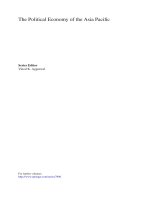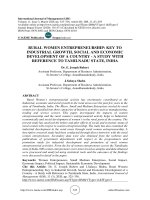Economic growth and economic development 688
Bạn đang xem bản rút gọn của tài liệu. Xem và tải ngay bản đầy đủ của tài liệu tại đây (121.87 KB, 1 trang )
Introduction to Modern Economic Growth
Skill premium
ET2--endogenous
technology demand
ET1--endogenous
technology
demand
CT--constant
technology
demand
Relative Supply of Skills
Figure 15.3. The relationship between the relative supply of skills
and the skill premium in the model of directed technical change.
relative technologies, NH /NL , constant, and thus only features the usual substitution effect. The fact that this curve is downward-sloping follows from basic producer
theory. The curve marked as ET1 applies when technology is endogenous, but the
condition in Proposition 15.4, that σ > 2, is not satisfied. We know from Proposition
15.3 that even in this case an increase in H/L will induce skill-biased (H-biased)
technological change. This implies that when H/L is higher than its initial level, the
constant-technology demand curve, CT must shift to the right. When it is below,
CT must shift to the left. Consequently, the locus of points that the endogenoustechnology demand, ET1 , is shallower than CT . There is an obvious relationship
between this result and Samuelson’s LeChatelier principle, which states that longrun demand curves, which apply when all factors can adjust, must be more elastic
than the short-run demand curves which hold some factors constant. We can think
of the endogenous-technology demand curve as adjusting the “factors of production”
corresponding to technology. However, since in basic producer theory all demand
curves must be downward-sloping, even with the LeChatelier principle, the resulting
674









